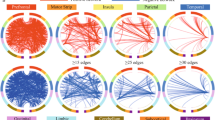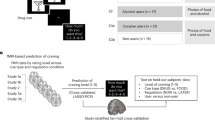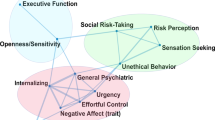Abstract
Treatment outcomes for individuals with substance use disorders (SUDs) are variable and more individualized approaches may be needed. Cross-validated, machine-learning methods are well-suited for probing neural mechanisms of treatment outcomes. Our prior work applied one such approach, connectome-based predictive modeling (CPM), to identify dissociable and substance-specific neural networks of cocaine and opioid abstinence. In Study 1, we aimed to replicate and extend prior work by testing the predictive ability of the cocaine network in an independent sample of 43 participants from a trial of cognitive-behavioral therapy for SUD, and evaluating its ability to predict cannabis abstinence. In Study 2, CPM was applied to identify an independent cannabis abstinence network. Additional participants were identified for a combined sample of 33 with cannabis-use disorder. Participants underwent fMRI scanning before and after treatment. Additional samples of 53 individuals with co-occurring cocaine and opioid-use disorders and 38 comparison subjects were used to assess substance specificity and network strength relative to participants without SUDs. Results demonstrated a second external replication of the cocaine network predicting future cocaine abstinence, however it did not generalize to cannabis abstinence. An independent CPM identified a novel cannabis abstinence network, which was (i) anatomically distinct from the cocaine network, (ii) specific for predicting cannabis abstinence, and for which (iii) network strength was significantly stronger in treatment responders relative to control particpants. Results provide further evidence for substance specificity of neural predictors of abstinence and provide insight into neural mechanisms of successful cannabis treatment, thereby identifying novel treatment targets. Clinical trials registation: “Computer-based training in cognitive-behavioral therapy web-based (Man VS Machine)”, registration number: NCT01442597. “Maximizing the Efficacy of Cognitive Behavior Therapy and Contingency Management”, registration number: NCT00350649. “Computer-Based Training in Cognitive Behavior Therapy (CBT4CBT)”, registration number: NCT01406899.
This is a preview of subscription content, access via your institution
Access options
Subscribe to this journal
Receive 12 print issues and online access
$259.00 per year
only $21.58 per issue
Buy this article
- Purchase on Springer Link
- Instant access to full article PDF
Prices may be subject to local taxes which are calculated during checkout


Similar content being viewed by others
Data availability
Preliminary data on the cannabis abstinence network were presented at the Society for Biological Psychiatry’s 2022 Annual Scientific Meeting, New Orleans, LA.
References
Dutra L, Stathopoulou G, Basden SL, Leyro TM, Powers MB, Otto MW. A meta-analytic review of psychosocial interventions for substance use disorders. Am J Psychiatry. 2008;165:179–87.
Hayes A, Herlinger K, Paterson L, Lingford-Hughes A. The neurobiology of substance use and addiction: evidence from neuroimaging and relevance to treatment. Bjpsych Adv. 2020;26:367–78.
Verdejo-Garcia A, Lorenzetti V, Manning V, Piercy H, Bruno R, Hester R, et al. A roadmap for integrating neuroscience into addiction treatment: a consensus of the neuroscience interest group of the international society of addiction medicine. Front Psychiatry. 2019;10:877.
Yip SW, Kiluk B, Scheinost D. Toward addiction prediction: an overview of cross-validated predictive modeling findings and considerations for future neuroimaging research. Biol Psychiatry Cogn Neurosci Neuroimaging. 2020;5:748–58.
Moeller SJ, Paulus MP. Toward biomarkers of the addicted human brain: Using neuroimaging to predict relapse and sustained abstinence in substance use disorder. Prog Neuropsychopharmacol Biol Psychiatry. 2018;80:143–54.
Yip SW, Scheinost D, Potenza MN, Carroll KM. Connectome-based prediction of cocaine abstinence. Am J Psychiatry. 2019;176:156–64.
Lichenstein SD, Scheinost D, Potenza MN, Carroll KM, Yip SW. Dissociable neural substrates of opioid and cocaine use identified via connectome-based modelling. Mol Psychiatry. 2021;26:4383–93.
Shen X, Finn ES, Scheinost D, Rosenberg MD, Chun MM, Papademetris X, et al. Using connectome-based predictive modeling to predict individual behavior from brain connectivity. Nat Protoc. 2017;12:506–18.
Finn ES, Shen X, Scheinost D, Rosenberg MD, Huang J, Chun MM, et al. Functional connectome fingerprinting: identifying individuals using patterns of brain connectivity. Nat Neurosci. 2015;18:1664–71.
Badiani A, Belin D, Epstein D, Calu D, Shaham Y. Opiate versus psychostimulant addiction: the differences do matter. Nat Rev Neurosci. 2011;12:685–700.
Carroll KM. The profound heterogeneity of substance use disorders: Implications for treatment development. Curr Dir Psychol Sci. 2021;30:358–64.
Conrod PJ, Nikolaou K. Annual research review: on the developmental neuropsychology of substance use disorders. J Child Psychol Psychiatry. 2016;57:371–94.
Conrod PJ. Personality-targeted interventions for substance use and misuse. Curr Addict Rep. 2016;3:426–36.
Edalati H, Conrod PJ. A review of personality-targeted interventions for prevention of substance misuse and related harm in community samples of adolescents. Front Psychiatry. 2018;9:770.
World Drug Report 2021 (United Nations publication, Sales No. E.21.XI.8). https://www.unodc.org/unodc/en/data-and-analysis/wdr2021.html.
GBD 2016 Alcohol and Drug Use Collaborators. The global burden of disease attributable to alcohol and drug use in 195 countries and territories, 1990-2016: a systematic analysis for the Global Burden of Disease Study 2016. Lancet Psychiatry. 2018;5:987–1012.
Connor JP, Stjepanovic D, Le Foll B, Hoch E, Budney AJ, Hall WD. Cannabis use and cannabis use disorder. Nat Rev Dis Prim. 2021;7:16.
McBain RK, Wong EC, Breslau J, Shearer AL, Cefalu MS, Roth E, et al. State medical marijuana laws, cannabis use and cannabis use disorder among adults with elevated psychological distress. Drug Alcohol Depend. 2020;215:108191.
Melis M, Frau R, Kalivas PW, Spencer S, Chioma V, Zamberletti E, et al. New vistas on cannabis use disorder. Neuropharmacology. 2017;124:62–72.
Brezing CA, Levin FR. The current state of pharmacological treatments for cannabis use disorder and withdrawal. Neuropsychopharmacology. 2018;43:173–94.
Gates PJ, Sabioni P, Copeland J, Le Foll B, Gowing L. Psychosocial interventions for cannabis use disorder. Cochrane Database Syst Rev. 2016;2016:CD005336.
Volkow ND, Michaelides M, Baler R. The neuroscience of drug reward and addiction. Physiol Rev. 2019;99:2115–40.
Lichenstein SD, Manco N, Cope LM, Egbo L, Garrison KA, Hardee J, et al. Systematic review of structural and functional neuroimaging studies of cannabis use in adolescence and emerging adulthood: evidence from 90 studies and 9441 participants. Neuropsychopharmacology. 2022;47:1000–28.
Garavan H, Brennan KL, Hester R, Whelan R. The neurobiology of successful abstinence. Curr Opin Neurobiol. 2013;23:668–74.
Kiluk BD, Nich C, Buck MB, Devore KA, Frankforter TL, LaPaglia DM, et al. Randomized clinical trial of computerized and clinician-delivered CBT in comparison with standard outpatient treatment for substance use disorders: primary within-treatment and follow-up outcomes. Am J Psychiatry. 2018;175:853–63.
Carroll KM, Ball SA, Martino S, Nich C, Babuscio TA, Nuro KF, et al. Computer-assisted delivery of cognitive-behavioral therapy for addiction: a randomized trial of CBT4CBT. Am J Psychiatry. 2008;165:881–8.
Carroll KM, Nich C, Lapaglia DM, Peters EN, Easton CJ, Petry NM. Combining cognitive behavioral therapy and contingency management to enhance their effects in treating cannabis dependence: less can be more, more or less. Addiction. 2012;107:1650–9.
Joshi A, Scheinost D, Okuda H, Belhachemi D, Murphy I, Staib LH, et al. Unified framework for development, deployment and robust testing of neuroimaging algorithms. Neuroinformatics 2011;9:69–84.
Lichenstein SD, Scheinost D, Potenza MN, Carroll KM, Yip SW. Dissociable neural substrates of opioid and cocaine use identified via connectome-based modelling. Mol Psychiatry. 2021;26:4383–93.
Shen X, Tokoglu F, Papademetris X, Constable RT. Groupwise whole-brain parcellation from resting-state fMRI data for network node identification. Neuroimage. 2013;82:403–15.
Rosenberg MD, Finn ES, Scheinost D, Papademetris X, Shen X, Constable RT, et al. A neuromarker of sustained attention from whole-brain functional connectivity. Nat Neurosci. 2016;19:165–71.
Rutherford HJV, Potenza MN, Mayes LC, Scheinost D. The application of connectome-based predictive modeling to the maternal brain: implications for mother-infant bonding. Cereb Cortex. 2020;30:1538–47.
Scheinost D, Noble S, Horien C, Greene AS, Lake EM, Salehi M, et al. Ten simple rules for predictive modeling of individual differences in neuroimaging. Neuroimage. 2019;193:35–45.
Rapuano KM, Rosenberg MD, Maza MT, Dennis NJ, Dorji M, Greene AS, et al. Behavioral and brain signatures of substance use vulnerability in childhood. Dev Cogn Neurosci. 2020;46:100878.
Yoo K, Rosenberg MD, Hsu WT, Zhang S, Li CR, Scheinost D, et al. Connectome-based predictive modeling of attention: comparing different functional connectivity features and prediction methods across datasets. Neuroimage. 2018;167:11–22.
Carroll KM, Nich C, DeVito EE, Shi JM, Sofuoglu M. Galantamine and computerized cognitive behavioral therapy for cocaine dependence: a randomized clinical trial. J Clin Psychiatry. 2018;79:17m11669.
Trivedi MH, Walker R, Ling W, Dela Cruz A, Sharma G, Carmody T, et al. Bupropion and naltrexone in methamphetamine use disorder. N Engl J Med. 2021;384:140–53.
Marek S, Tervo-Clemmens B, Calabro FJ, Montez DF, Kay BP, Hatoum AS, et al. Reproducible brain-wide association studies require thousands of individuals. Nature. 2022;603:654–60.
Rosenberg MD, Finn ES. How to establish robust brain-behavior relationships without thousands of individuals. Nat Neurosci. 2022;25:835–7.
Kulkarni KR, Schafer M, Berner LA, Fiore VG, Heflin M, Hutchison K, et al. An interpretable and predictive connectivity-based neural signature for chronic cannabis use. Biol Psychiatry Cogn Neurosci Neuroimaging. 2023;8:320–30.
Yalachkov Y, Kaiser J, Naumer MJ. Sensory and motor aspects of addiction. Behav Brain Res. 2010;207:215–22.
Naqvi NH, Gaznick N, Tranel D, Bechara A. The insula: a critical neural substrate for craving and drug seeking under conflict and risk. Ann N Y Acad Sci. 2014;1316:53–70.
Scheinost D, Hsu TW, Avery EW, Hampson M, Constable RT, Chun MM, et al. Connectome-based neurofeedback: A pilot study to improve sustained attention. Neuroimage. 2020;212:116684.
Greene AS, Gao S, Scheinost D, Constable RT. Task-induced brain state manipulation improves prediction of individual traits. Nat Commun. 2018;9:2807.
Acknowledgements
The current work was supported by K08DA051667 (SL), Women’s Health Research at Yale (SL), T32DA007238 (RK), R01DA039136 (MNP), K02AA027300 (BK), and YSM Office of Team Science (SWY, SL). Data collection was supported by P50DA09241 (MNP, BK), R01DA020908 (MNP), R01DA035058 (MNP) and R01DA019039 (MNP).
Author information
Authors and Affiliations
Contributions
SDL, BK, and SWY collaborated on conception and design of the current analyses. MNP and BK oversaw acquisition of the data. SDL, RK, FY, BK, and SWY contributed to analysis and interpretation of the data. SDL and FY drafted the article. All authors revised the article critically for important intellectual content and provided final approval for the version to be published.
Corresponding author
Ethics declarations
Competing interests
SDL, RK and FY report no competing financial interests in relation to the work described. MNP has consulted for Opiant Therapeutics, Game Day Data, Baria-Tek, the Addiction Policy Forum, AXA and Idorsia Pharmaceuticals; has been involved in a patent application with Yale University and Novartis; has received research support from Mohegan Sun Casino and the Connecticut Council on Problem Gambling; has participated in surveys, mailings or telephone consultations related to drug addiction, impulse-control disorders or other health topics; has consulted for and/or advised gambling and legal entities on issues related to impulse-control/addictive disorders; has provided clinical care in a problem gambling services program; has performed grant reviews for research-funding agencies; has edited journals and journal sections; has given academic lectures in grand rounds, CME events and other clinical or scientific venues; and has generated books or book chapters for publishers of mental health texts. BK is a consultant to CBT4CBT LLC, which makes versions of CBT4CBT (one of the treatments evaluated in the parent RCTs included in this study) available to qualified clinical providers and organizations on a commercial basis. SWF is a consultant for Sparian Biosciences.
Additional information
Publisher’s note Springer Nature remains neutral with regard to jurisdictional claims in published maps and institutional affiliations.
Supplementary information
Rights and permissions
Springer Nature or its licensor (e.g. a society or other partner) holds exclusive rights to this article under a publishing agreement with the author(s) or other rightsholder(s); author self-archiving of the accepted manuscript version of this article is solely governed by the terms of such publishing agreement and applicable law.
About this article
Cite this article
Lichenstein, S.D., Kohler, R., Ye, F. et al. Distinct neural networks predict cocaine versus cannabis treatment outcomes. Mol Psychiatry 28, 3365–3372 (2023). https://doi.org/10.1038/s41380-023-02120-0
Received:
Revised:
Accepted:
Published:
Issue Date:
DOI: https://doi.org/10.1038/s41380-023-02120-0



